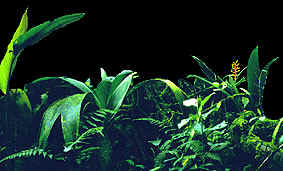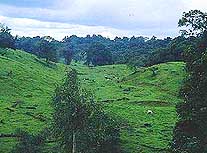![]()
Tropical trees often grow very large and can live for two or three hundred years, but during their life they struggle for survival. Tropical trees have to compete for light and nutrients, fight off parasites and invading insects, and try not to become top-heavy with the massive amounts of epiphytes that are often found in the treetops.
|
When a rainforest tree dies and falls over, it is a big event. Vines and lianas that connect the canopy, usually a tree to take neighbouring trees down with it. After the noise dies, a 'light gap', which is a fairly large sunny spot in the middle of the rainforest, is left. Light is a vital ingredient for plants to grow. In a dense, closed-canopy rainforest only between 1-2% of the sunlight reaches the forest floor. It is very dark in a rainforest, and small plants struggle to survive in the shade. So the sunlight touching the forest floor in the new light gap, starts the germination of most of the seeds that are stored in the forest floor. Within days of a tree falling, lots of seedlings start to grow. Then weedy plants and vines (often called 'pioneer species') rapidly colonise the light area and overgrow everything. These plants take the light away from many slow growing plants, and not all of the seedlings survive. However, over time other species of trees start to replace the pioneer vegetation. |
 |
 |
Eventually, the pioneer species disappear because their preferred habitat (open sunny areas) fills up with skinny, medium-sized trees. Slowly over time, the forest area eventually reaches its original species diversity of plants and animals that it had before the tree fell down. Nobody knows exactly how long it takes before a rainforest is back to its full grown state after it has been disturbed. When a tree falls, it is a relatively small area of the forest that is disturbed. However, when people farm in the rainforests they usually cut down a lot of trees and clear all of the natural vegetation. This makes it much harder for the rainforest to grow back to its original species diversity of plants and animals. For example, more than 500 years ago Indians in Central America cut down areas of the rainforest for farming, and the forest still has not grow back to its original state. |
|
This is one of the reasons why deforestation in the tropics has such a devastating effect. Just think of how long it will take to have an original forest again on an area that is completely clear-cut? Vocabulary The original rainforest, before it is disturbed, is call a 'primary forest'. The dense, low forest that the pioneer species create is called a 'secondary forest'. The pattern of rapid colonisation, and slow recovery until the forest eventually reaches its original state is called 'biological succession'. It is the way a forest rejuvenates, bit by bit because older trees die and new trees have light to grow. |
|
